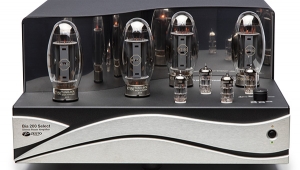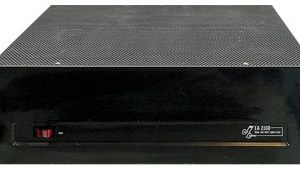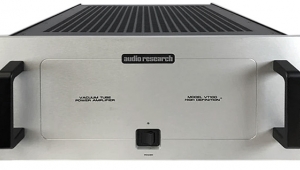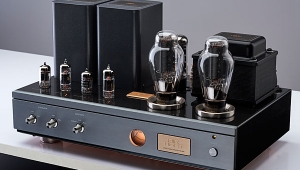| Columns Retired Columns & Blogs |
Sonic Frontiers Power 3 monoblock power amplifier
The internal battle between the head and the heart, between the analytical and romantic sides of our nature, is a difficult one. I'm an engineer, so it seems as if my cold, calculating side should have the upper hand. This is true in a lot of cases; most of my actions and decisions are based on straightforward, logical analyses. However, things like a house full of castaway dogs, or a garage full of quixotic British cars and Italian motorcycles, suggest that my heart holds sway reasonably—perhaps distressingly—often.
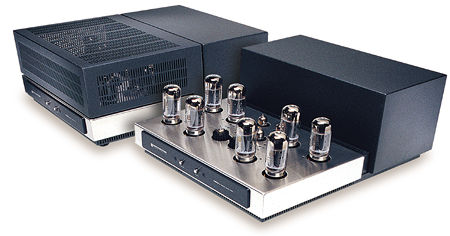
This struggle is often in full force when I venture into the audio world. Inevitably, there's a huge gap between a dispassionate accounting of a component's pluses and minuses and my holistic, emotional response to the music it produces. Perhaps this reflects shortcomings in my analysis or communication skills. Or it could be a contradiction that's inherent in trying to apply a fragmented, analytical picture to something as emotional and organic as my reaction to music.
Whatever the reason, it's rare that an audio component excels across the board: from the most analytical perspective to the most emotional. LPs, for example, have obvious flaws and don't appeal to my logical side. Yet they manage to be more musically satisfying than CD's "perfect sound forever." Conversely, when the Melos SHA-Gold preamplifier of a few years back impressed me mightily, though I was hard-pressed to come up with specific criticisms of its performance, it never seemed as musically satisfying as an analysis suggested it should be. The music never connected with me emotionally, never captured my heart.
Perhaps the best example in my recent history is a pair of integrated amps I auditioned a few years ago: one tube, one solid-state, both from the same manufacturer. The solid-state model was a technical marvel whose engineering and performance I truly admired, but when the lights went down and the music went on, I unfailingly found its tube sibling more satisfying.
This contradiction—or spectrum of response—is the backdrop against which the Sonic Frontiers Power 3 must be judged. SF has earned a reputation as a high-end heavyweight, and the Power 3 is their flagship amplifier. Its $9999/pair price tag isn't exorbitant by today's standards, but still, this isn't a case of an amplifier being "good for the price" or "a reasonable compromise." I expect a product like the Power 3 to do it all: to amaze and impress my analytical side, and to enchant and captivate my heart.
Drawing battle lines
Starting from a purely analytical perspective, the Power 3's spec sheet confirms that it's a serious assault on the state of the art. It combines a tried-and-true tube circuit with modern, innovative engineering. The basic circuit uses four 6922 tubes as the input/driver stage, followed by a pair of 5687s for high-voltage drivers, and eight 6550C output tubes. The driver and output stages are direct- rather than capacitor-coupled, to improve transient response and to avoid any signal blocking that might occur due to residual charge on the capacitors.
The circuit is fully balanced, input to output—even including the output transformers. Although there is only one set of speaker binding posts, the amps can be configured for 8, 4, or 2 ohm loads by a simple operation of changing a set of internal connections. Mine were factory-set at 4 ohms to match the Thiel CS7.2s; I used the same setting to match the 5 ohm load of the Magnepan MG3.6/Rs.
A peek inside confirms that the boards and layout are neat and professional, and the assembly is beautifully done. Similarly, the parts quality is extraordinary, even at this price. The tubes are sourced from Sovtek, Svetlana, and Philips (US JANs), and are exactingly graded and matched. Passive components include Solen and Wima capacitors and Vishay and Roderstein resistors. The heavy binding posts are rhodium-plated, solid-copper units from Cardas, and the input jacks and internal wiring are from Kimber.
As I moved outward to the Power 3's construction quality and user interface, my analytical perspective still dominated—but the less tangible, emotional response began to contribute. Sure, form follows function, and I admire and respect simple, logical, functional controls. But less tangible factors like fit and finish, proportion, and feel also come into play.
The Power 3 scores 10s across the board here as well. Fit and finish are outstanding: The heavy, laser-cut, stainless-steel chassis panels fit perfectly, and are securely assembled and thoroughly damped. The finish treatment combines smooth, brushed surfaces and black, textured, powder-coated ones. Corners are chamfered exactly how and where they should be, and the overall proportions are "just so." Imagine a top-level Mercedes or BMW sedan, and you'll have the right idea.
The Power 3's controls are logical and well executed. Front-panel buttons control power and select between Standby and Operate, each flanked by an LED that glows red or green to indicate operational status. Standby mode gets (or keeps) things warmed up for a listening session while drastically reducing the wear on the power tubes.
Red on the Power LED indicates that the amp is muted, which is one of the four positions on the rear-panel Input Select switch. The Mute function not only permits cable swaps without shutting down the amp, it also activates the Power 3's simple, wonderfully user-friendly process of measuring and adjusting tube bias. The other three positions on the Input switch select between balanced (XLR), single-ended (RCA), and reversed-polarity single-ended. Cardas five-way binding posts and a removable power cord complete the package.
All this would be enough to put the Power 3 in good stead, but Sonic Frontiers tosses in a few more niceties that reflect their attention to detail. For example, 5687s run hot, so SF includes Pearl tube coolers. All of the tools required to assemble, install, and maintain the amps are included, as are white cotton gloves to handle the tubes—to avoid getting fingerprints on the glass. Even the manual is simple and thorough. My favorite goody, however, is that only two screws must be loosened to remove the chassis' top section (for biasing), and the screws are spring-loaded and captured.
Why can't everything be built this well, and show the end user this level of consideration?
System and etup
I used two different pairs of Power 3s over a 12-month period, with a wide variety of systems and setups. Recent listening sessions, and most of my specific examples, refer to a system that paired the Power 3s with Magnepan 3.6/R loudspeakers and a VAC CPA1 Mk.III preamplifier. Analog duties were performed by my VPI TNT IV/JMW Memorial 12" combo, fitted with a Grado Reference cartridge and suspended on a dedicated TNT stand and Bright Star TNT Air Mass/Big Rock combo. Wadia 830 and Ultech UCD-100 CD players handled discs, and everything was wired up with JPS Superconductor 2 cables, single-ended upstream of the VAC and balanced from there on. To help triangulate the Power 3's character, I used comparisons with pairs of VTL Ichibans and Mark Levinson No.20.6s, and a VAC Renaissance 70/70 and a Krell KSA-250.
Use and listening
As I've noted above, the Power 3 was a delight to set up, install, and use. My samples were reliable, dead quiet (save for one amp that unfailingly emitted a couple of quick spits shortly after turn-on), and not much more than warm in operation. The amps' biases drifted a bit in the first few days of operation (I ran them continuously for a week before doing serious listening), but were rock-solid after that. My experience with the Thiel CS7.2 suggest that the Power 3 has enough power and control to drive difficult loads with aplomb.
The Power 3's most obvious characteristic—one that appealed greatly to my analytical side—was its flat tonal balance and incredible consistency from top to bottom. I cued up one of my favorite LPs, the Munch/Boston reading of Debussy's La Mer (RCA LSC-2111), and kicked back. The double basses and bass drum were deep and articulate, with superb precision and pitch definition. Moving up through the cellos, woodwinds, and violins, it was a continuous flow, with no change in the amp's character. Instruments retained their harmonic balance and texture across their ranges, and the overall mix—instruments, sections, soundstage, and ambience—was continuous as well.
The SF's clean, controlled presentation extended up into the top end. There was no change in character whatsoever as violins or pianos, for example, moved up to the very top of their range. Cymbals were open and airy, and even piccolos were obviously the same instruments playing in the same space, from the bottom to the very top of their range. Occasionally, a touch of edginess crept into massed violins during crescendos near the top of their range. The majority of the time, however, the Power 3's top end was smooth—as well as clear, clean, and open.
In comparison, all of the other amps I used had slight but noticeable aberrations in frequency response. Comparison with the Power 3 made it obvious that the Mark Levinson No.20.6, for instance, had a dark, silvery sound: slightly bloomy upper bass, sweet, prominent upper midrange and lower treble, and closed-in top end.
- Log in or register to post comments
